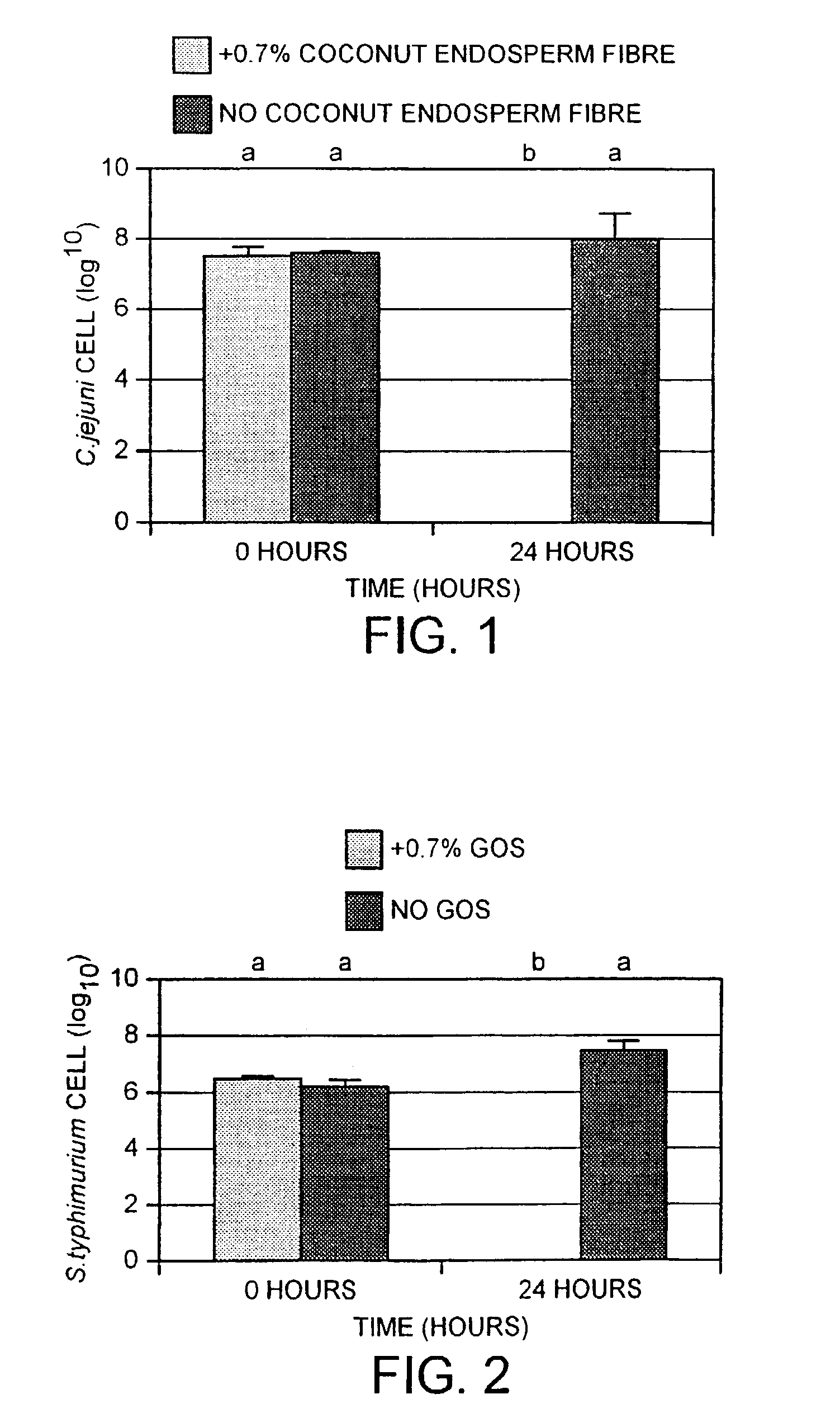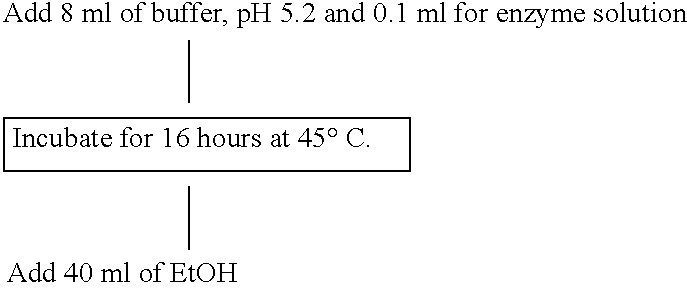Treatment of infection in animals
a technology for treating infection and animals, applied in the field of treating infection in animals, can solve problems such as reducing or eliminating treatment options, and achieve the effects of reducing the ph of the large intestine, reducing or eliminating viable pathogenic bacteria
- Summary
- Abstract
- Description
- Claims
- Application Information
AI Technical Summary
Benefits of technology
Problems solved by technology
Method used
Image
Examples
example 1
The Effect of Fructooligosaccharide (FOS) on the Survival of Campylobacter jejuni in a Model of the Canine Intestine
Method
[0046]Campylobacter jejuni cells were grown from stock cultures and cultured at 37° C. under microaerobic conditions (5% O2, 10% CO2 and 85% N2). Liquid cultures were grown in 20 ml volumes in 50 ml conical flasks shaken on an orbital shaker. Overnight cultures grown in Mueller Hinton (MH) broth (Oxoid) were adjusted to A600 1.0 before inclusion in the assay.
[0047]Flasks were set up with 200 ml MH broth, 1 ml of the adjusted Campylobacter jejuni culture, and 2 g fresh faeces. To test flasks, 1.4 g FOS (CoSucra) was added and swirled to mix. Control flasks had no further additions.
[0048]Flasks were sampled at the start (0 hours) and end (24 hours) of the experiment to determine viable counts of Campylobacter jejuni cells by serially diluting samples from the flasks and plating dilutions onto Campylobacter selective agar (LabM). Plates were incubated microaerobical...
example 2
The Effect of Galactooligosaccharide (GOS) on the Survival of Campylobacter jejuni in a Model of the Canine Intestine
Method
[0055]The method used was as per Example 1 substituting FOS for GOS. The results from the individual experiments are shown in Table 2. GOS was from Borculo Domo ingredients (BDI).
Results
[0056]After a 24-hour microaerobic incubation, no viable Campylobacter jejuni cells could be recovered from flasks that had GOS added. In contrast, Campylobacter jejuni cells were recovered from the flasks that contained no GOS at around 108 cells per ml. The results from the 6 individual experiments are shown in Table 2.
[0057]
TABLE 2Numbers of viable Campylobacter jejuni cells (log10) recovered from themodel of the canine large intestine with and without the addition of GOS.←----log10 colony forming units of Campylobacter jejuni ---→Faecal0 hours0 hours24 hours24 hoursSample+0.7% GOSNO GOS+0.7% GOSNO GOSGR17.287.2308.71L15507.427.208.68L1367.157.0908.88L15267.067.1307.22L15157.5...
example 3
The Effect of Coconut Endosperm Fibre on the Survival of Campylobacter jejuni in a Model of the Canine Intestine
Method
[0060]Investigation into the effect of coconut endosperm fibre on the survival of Campylobacter in the canine intestine.
Summary
[0061]Campylobacter is one of the most predominant gastrointestinal pathogens causing both clinical and non-clinical infections in dogs.
[0062]An in vitro model of the canine large intestine has been developed to test the effect of novel fibres on the survival of canine bacterial pathogens.
[0063]Inclusion of coconut endosperm fibre in this model resulted in the elimination of viable Campylobacter jejuni cells from the system.
Methods
[0064]Campylobacter jejuni cells were grown from stock cultures and cultured at 37° C. under microaerobic conditions (5% O2, 10% CO2 and 85% N2). Liquid cultures were grown in 20 ml volumes in 50 ml conical flasks shaken on an orbital shaker. Overnight cultures grown in Mueller Hinton (MH) broth (Oxoid) were adjuste...
PUM
| Property | Measurement | Unit |
|---|---|---|
| volumes | aaaaa | aaaaa |
| volumes | aaaaa | aaaaa |
| temperature | aaaaa | aaaaa |
Abstract
Description
Claims
Application Information
 Login to View More
Login to View More - R&D
- Intellectual Property
- Life Sciences
- Materials
- Tech Scout
- Unparalleled Data Quality
- Higher Quality Content
- 60% Fewer Hallucinations
Browse by: Latest US Patents, China's latest patents, Technical Efficacy Thesaurus, Application Domain, Technology Topic, Popular Technical Reports.
© 2025 PatSnap. All rights reserved.Legal|Privacy policy|Modern Slavery Act Transparency Statement|Sitemap|About US| Contact US: help@patsnap.com



